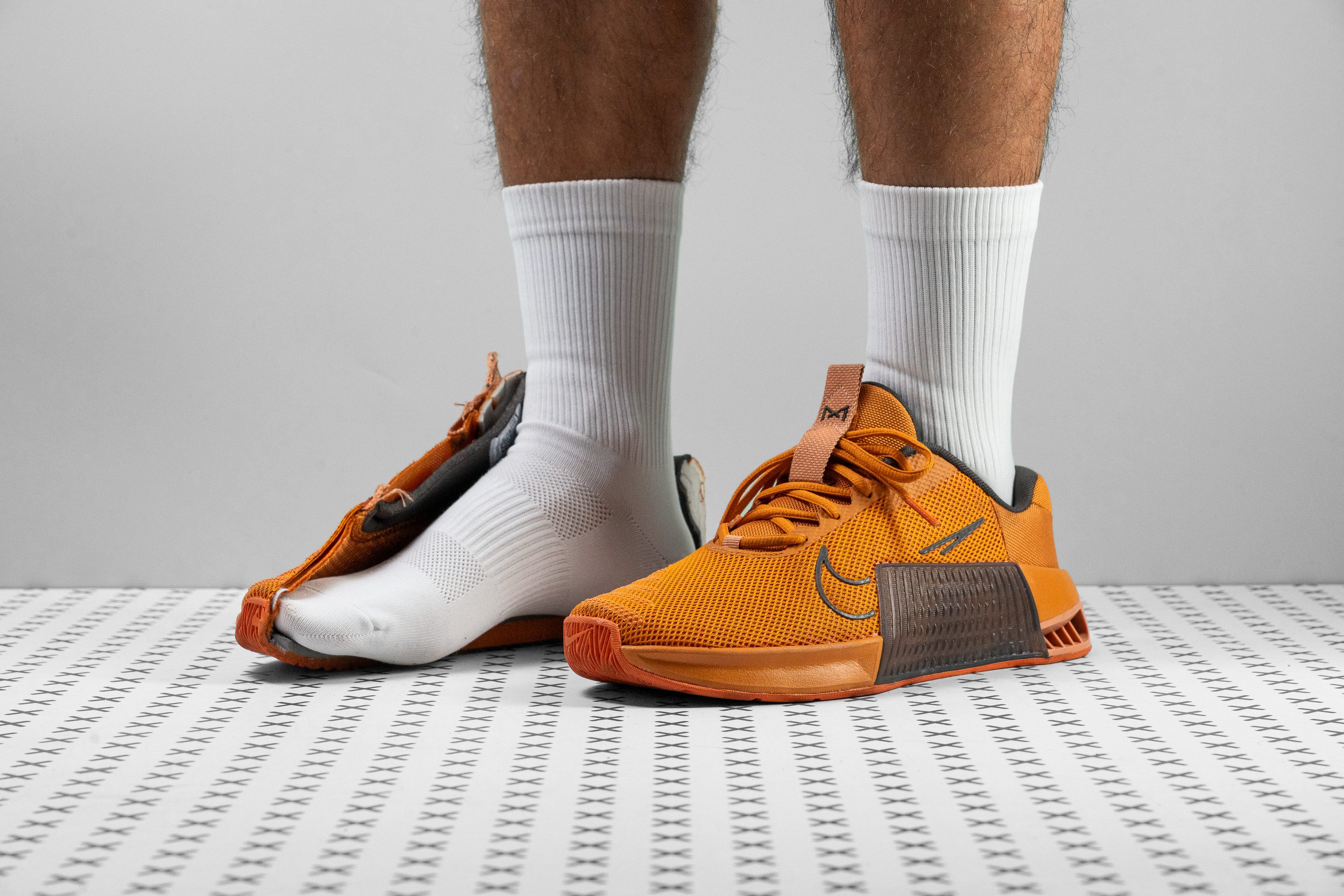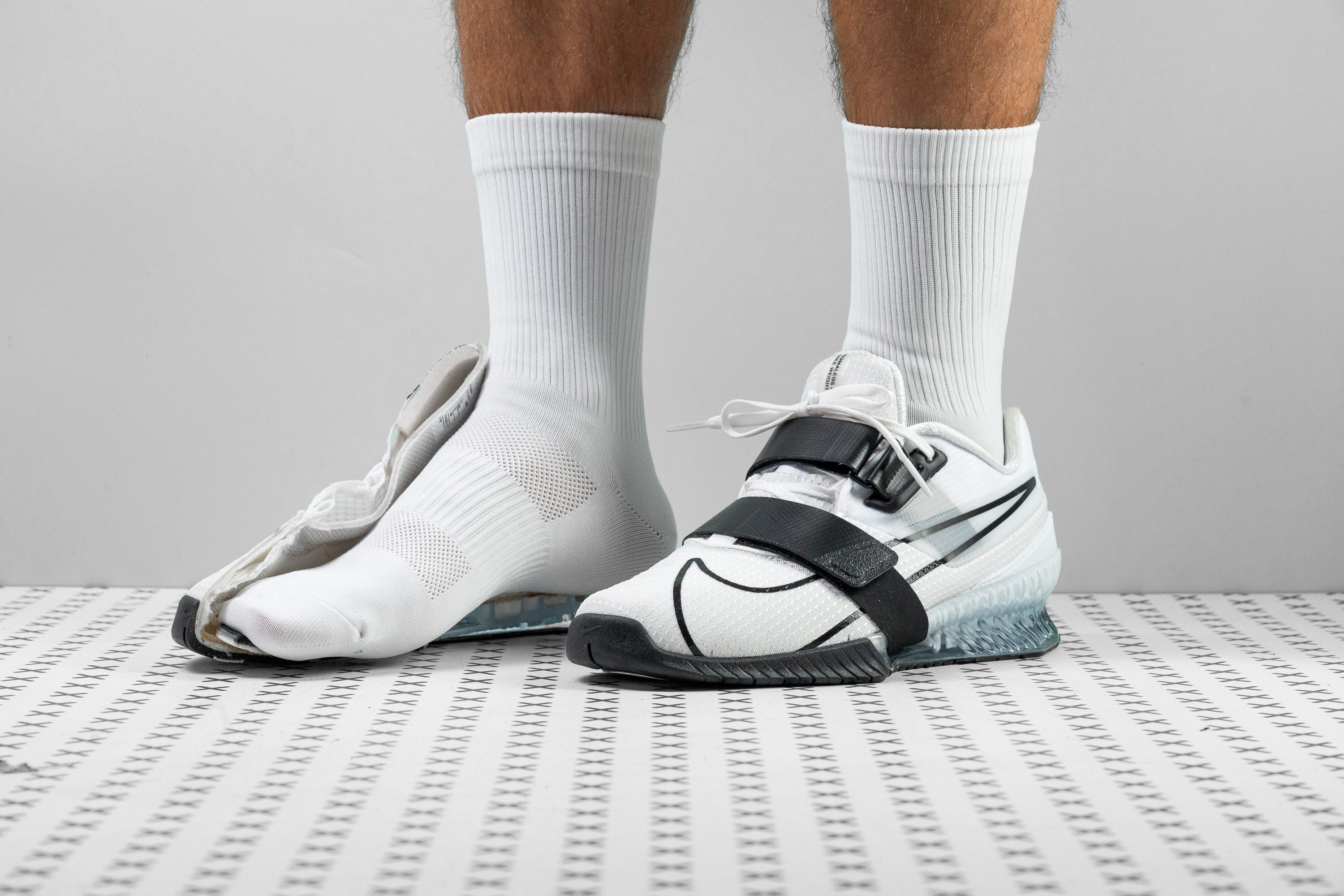






































What makes it the best?
We crown the Nike Free Metcon 5 as the best high-intensity interval training (HIIT) shoe on record because it is insanely serious about support and lockdown. Additionally, this shoe also delivers a lot of plushness and underfoot comfort. Not to mention that it is amazingly lightweight.
The moment we stepped into the Nike Free Metcon 5, we immediately noticed the cloud-like feel of its cushioning system. In the lab, our HA durometer measurements confirmed that it’s a whole 55% softer than average at 17.4 HA! We loved the shock absorption it offered for non-stop jumping streaks of our workouts.
At 11.2 oz or 317g, the average weight of training shoes is already on the lower end of the scale. But the Free Metcon 5 is still lighter at 10.5 oz or 298g. No wonder we never felt weighed down during our runs, leaps, and jumps.
This shoe surely provided great foot containment, and we have its well-padded collar and fully gusseted tongue to thank for that. The thickness of the collar padding closed off any space between the foot and the shoe, effectively enhancing the fit. The gusseted tongue also stayed in its place and effectively held down our feet even if our movements became a bit aggressive.
We were just a little disappointed with the upper. After a 12-second Dremel test in our lab, we already observed considerable damage in it. Those who are looking for a shoe that lasts long may want to look for something else.
Pros
- Impressively stable
- Noteworthy ankle support
- Awesomely close-fitting
- Roomy toebox
- Nice and airy upper
- Comfortable for all-day wear
- Quite cushiony
- Notably lightweight
- Exceptionally flexible
- Stylish design and overall look
Cons
- Not for long runs (2-3 miles max)
- Upper lacks durability
Best training shoes overall












































What makes it the best?
It’s not surprising that the Reebok Nano X4 is the best out of all the training shoes that we tried. This shoe offered pampering from all directions. Its cushioning is plush so impact protection was always there. Aside from having a breathable upper, it also has an inner sleeve that truly felt great. Finally, it had an outsole that was big on durability.
After measuring its softness using a caliper, we learned that the midsole at the heel of the Nano X4 has a softness score of 30.0. This was just around the 27.3 average. This setup delivered a nice balance of softness and ground feel, which we truly appreciated.
After conducting a breathability test in the lab, the upper got a score of 4 out 5. This means that it allowed air (we used smoke during the test for more visibility) to go out of the shoe quickly. Indeed, it kept our feet dry and comfortable.
The outsole, which felt sturdy to the touch, made this shoe truly fit for the outdoors. We rubbed our Dremel against it, and our assault only left 0.5 mm of damage–far from the 1.0 mm that we would have seen in the typical outsole.
We just don’t like the fact that the Nano X4 couldn’t accommodate the wide-footers among us. It did not offer more space than a typical trainer. At its widest point, the toe box is 99.4 mm while the average is 99.9 mm.
Pros
- Fantastic wear resistance
- Great balance of cushioning and stability
- Feels grounded and supportive
- Secure foot lockdown
- A fully-gusseted tongue (finally)
- Nice breathability
- Lighter than the X3
- Great grip on gym floors
Cons
- Not for heavy lifting
- Not for wide feet
Best training shoes for Crossfit














































What makes it the best?
Among all the training shoes we exercised with and cut open in the lab, Metcon 9 is undoubtedly the best for Crossfit. With its sturdy base, and amazing foothold and grip, it performs any WOD exceptionally and shines best in lifting.
We did heavy squats, snatches, and deadlifts and the Metcon’s base assisted us very well even without a raised heel. Our caliper measures its below-average heel and forefoot stack at 21.5/16.0 mm, making us more sensitive to ground feedback. It offers superb lockdown thanks to its supportive upper and raised sidewalls.
Since Crossfit isn’t all about lifting, we tested Metcon 9 against box jumps, burpees, rope climbs, and lunges. It proved itself versatile in most CrossFit activities, with an unresisting midsole that flows with our movements. Upon checking with our bend test, it emerged 15.0% more flexible than average.
Metcon 9 provides excellent stability and grip. This boosted our confidence, making us enjoy the WOD even more. With a caliper in hand, we measured the forefoot and heel to be 6.9/7.7 mm wider than average. Such a large contact area, together with the non-compressible Hyperlift under the heel, helps us stabilize our feet while lifting heavy loads.
We discovered the forefoot lacks cushion for repetitive rope jumps. We recommend exploring more cushioned shoes for this type of workout.
Pros
- Exceptionally stable for weightlifting
- One of the most durable cross-trainers
- The best shoe for rope climbs
- Reliable foot containment
- Very comfortable in-shoe feel
- Nice grip on gym floors
- Accommodates wide feet (finally!)
- Surprisingly flexible
Cons
- Heavier than average (and previous Metcons)
- Not great for cardio workouts and rope jumps
- So-so breathability
Best training shoes for weightlifting




























What makes it the best?
When it comes to lifting, the Nike Romaleos 4 easily rose above other training shoes because of its amazingly firm midsole, impressively wide base, and totally firm structure. Our feet were surely kept in place no matter how heavy we were hoisting above our heads.
We learned through our HA durometer measurements in the lab that the midsole is a lot firmer than average. While the average HA durometer rating is 75.0, the Romaleos 4’s score was as high as 97.0! There really was no wobbliness because of this much firmness.
The wide midsole platform contributed a lot to the shoe’s overall stability. Our caliper measurements revealed that the platform is 111.5 mm (average is 107.1 mm) wide at the forefoot while it’s 91.3 mm (average is 87.1 mm) wide at the heel.
The shoe’s minimal flexibility also did so much in keeping our feet in place and ensuring that we got the support that we needed. Using a digital force gauge, we uncovered that we needed to exert 40.4N of force to bend this shoe at 90 degrees. The typical trainer would need only 26.0N.
We just didn’t like that our feet were sweating a lot when inside this shoe. There was not much ventilation! True enough, this shoe only got a 2 out of 5 when we subjected this shoe to our smoke breathability test in the lab.
Pros
- Phenomenal stability
- Sturdy platform and sole
- Better lockdown with two straps
- Comfortable for a lifting shoe
- True to size
- Efficient traction
- Appealing looks
Cons
- Upper lacks durability
- Not for narrow ankles
- Not breathable



